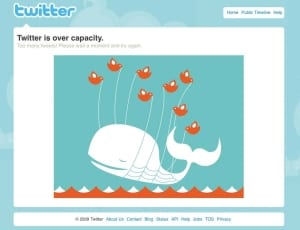
Twitter is a social media platform that facilitates communication between you and your “followers,” as well as those you follow and their followers.
Twitter is not about standing on a mountaintop and shouting, “I was just quoted in The New York Times,” and hoping someone hears you. Rather, Twitter is about standing on that mountaintop and shouting your news to the guy standing on the next mountaintop, and hoping that he will relay your message to the next guy on the next mountain or elsewhere, and so on until your message is heard throughout the world. Twitter has the ability to send your status updates virally, much like a chain letter that gets passed on from one person to their friends.
However, your message can get altered along the way, and you have little to no control over that. On Twitter, every status update will automatically appear in your followers’ incoming information stream, which is why posts like, “I just did a bleph,” are likely to cause your followers to “unfollow” you.
If you bombard your followers with useless information or spam-like posts, you will make more enemies than friends. For example, a good strategy is to post a full range of tweets; some may be self-promotional in nature (but not all of them). Alternating between tweets that toot your own horn and posts that comment on news items, current events, good causes, milestones, holidays, and celebrity activities will allow you to engage with a wider range of Twitterers. You may repeat some of your tweets some of the time, but you have to keep the stream of posts interesting, entertaining, and relevant to your followers.
Losing followers on Twitter can be multifactorial. In the first place, some of your followers may be spammers who got nailed by Twitter and booted off. Other users may have just dropped out on their own. Still more reached the arbitrary Twitter-imposed 2,000 limit to how many users you can follow unless at least 2,000 are following you—and unfollowed users who are not posting relevant or interesting content.
On Twitter, it is not quantity but quality that counts. It is wiser to have 1,000 followers who are like-minded individuals or in related industries than 2,500 followers composed largely of spammers, Forex, multilevel marketers, and Donald Trump promoters.
Using third-party applications can offer an improved user interface, allowing you to bypass the Twitter Web site (which is usually on the fritz) and further enhance your Twitter experience.
These applications come with the features you get on the Twitter site plus additional functionality that make Twitter easier to manage, especially if you have multiple user names. For example, with Tweetdeck or Hootsuite, and similar applications, you can set up columns for @replies, direct messages, mentions, and archived tweets. You are able to follow multiple accounts and post simultaneously across your accounts, as well as to your Facebook and LinkedIn profiles.
These applications are real time savers that greatly increase productivity. In fact, for most of us, using the Twitter site directly has become wholly impractical and ineffective due to the constant glitches and error messages.
STREAMLINE YOUR TWEETING
The first step in managing your information stream is to manage it effectively. When you start to follow hundreds or thousands of people on Twitter, and more people start following you, third-party applications become a necessity. The best way to approach Facebook and Twitter is to strive to streamline the process so you can stay on top of your posts and tweets, and interact with your friends, followers, and fans.
However, one sure way to get booted off Twitter is to re-tweet spam messages or attempt to log into third-party applications that claim to allow you to buy followers or to collect followers quickly. If you are in doubt whether a Twitter helper application is legitimate, click on the Twitter Help link on the upper right bar of your screen and search the Help Center to investigate further. You will often find relevant information as well as posted responses from other Twitter users. If you do allow an unscrupulous third-party application to attempt to spam your followers, the easiest way to shut it down is to just change your Twitter account password.
Wendy Lewis is president of Wendy Lewis & Co Ltd Global Aesthetics Consultancy, author of 10 books, and a regular contributor to PSP. She can be reached at . Follow her on twitter.com/cosmeticmed.




